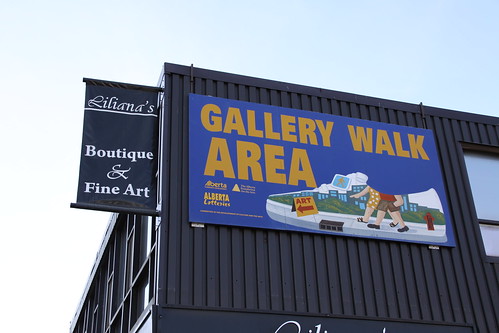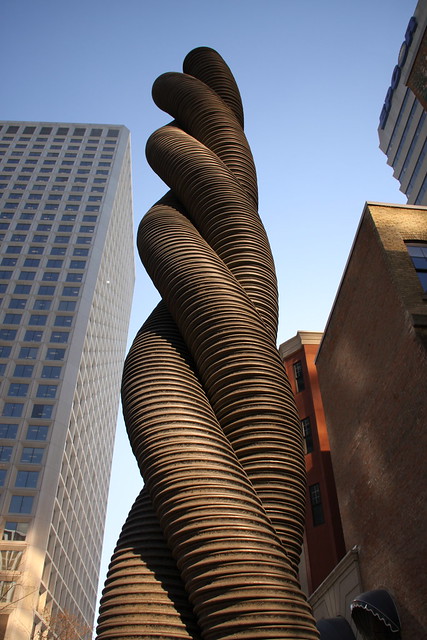
I had the pleasure of joining over 200 Edmontonians to share ideas about making our city more friendly to the arts at Mayor Stephen Mandel‘s Arts Think Tank today at the Sutton Place Hotel. The day was hosted by Dianne Kipnes and Brian Webb and included a though-provoking talk by author Peter Kageyama, two “pod discussions,” a mini-Pecha Kucha event hosted by the Next Gen group, and a cafe-style panel discussion with a handful of representatives from business, arts, and community groups hosted by Todd Babiak.
“Investment in the arts is investing in the very soul and identity of a city,” Brian Webb
Because the format of the day was very idea focused, participants did not have much of an opportunity to discuss content. The idea collection started today will carry on in smaller groups over the summer and into another large group Think Tank discussion in the fall, when I hope participants will have more time to discuss the content of their ideas.
The discussions and ideas shared over the course of the day were respectful, but there were also odd bursts of provocative comments made.
“Being cheaper is not the Alberta advantage” – Ken Cantor of Qualico Developments on investing in the arts.

When writing about the arts in Edmonton and Alberta, I try especially hard not to revert to Malcolm Gladwell-induced buzz words like “tipping points” and “outliers.” Keeping this in mind, here are a few thoughts I had about the day:
Art in community gathering places & embracing cultural literacy.
This is not about a political ideology, it is about educating people to understand how art informs us of our past, helps us understand our present, and will shape our future. It is about recognizing the forms of creativity that surround us each day. I believe there is a strong role for cultural literacy in our primary and secondary education systems, but also for the broader community. Opening more community gathering places like schools, community halls, and parks as a place for artists to be create and perform their art while connecting and engaging with the larger community could be a way to increase cultural literacy. I think cultural literacy plays a big role in improving quality of life (and it also makes life a lot more fun).
Art not just for the downtown crowd.
With arts communities, installations, galleries, and gathering places tending to be concentrated in downtown and surrounding neighbourhoods, it is important not to forget the suburban expanse on that hugs our city. If the arts are to be relevant to our city, they must be relevant to all Edmontonians in all neighbourhoods. New ways should be approached to engage and connect artists with Edmontonians living in suburban neighbourhoods, especially in those which yet to establish strong community leagues or have not yet developed their own unique identity.
Thinking out of the box
Art does not have to be static and it does not have to be government sanctioned (or funded). Mr. Kageyama referenced a few examples in his talk of creative projects that have changed how people enjoy their cities and promote it to outsiders: Broken City Lab, High Line Park in New York, and the Grand Rapids LipDub:
Who should be invited into the discussion?
The 200 participants at today’s Think Tank came from a broad range of backgrounds, but there were groups who were noticeably absent from the discussion. Aboriginal Canadians, new Canadians, kids who are currently students in Kindergarden to Grade 12 school system, teachers and educators also need to be engaged in these discussions. I also hope that Edmonton’s elected school trustees are invited to participate in this discussion as it evolves.
Where are Edmonton’s Aboriginal Artists?
One thing that I noticed while travelling across Australia earlier this year was the prominence of traditional Aboriginal art. In Sydney, Canberra, Townsville, Cairns and Darwin, there were numerous galleries that showcased and sold traditional art created by Aboriginal artists. As the city with Canada’s second largest urban Aboriginal population (52,100 people or 5% of the city’s population), Edmonton should have space where this growing community’s artists can access in order to create, showcase, and perform their traditional art.
Now that I have shared some of my ideas, what do you think?

10 replies on “thoughts about the mayor’s think tank. our arts. our edmonton.”
but there were groups who were noticeably absent from the discussion.
Curious to know if anyone from the UofA was there. Seems like inviting the institution that pumps out thousands of creatives every single year might be a good idea.
Thanks for the comment, Andy. If there was one group that was not underrepresented, it was probably the U of A crowd. The Dean of Arts was in the same first discussion “pod” as I was. I also noticed academics and administrators from the School of Business and the school of Fine Arts.
Great post, Dave.
Interesting stuff about developing cultural literacy and bringing the arts to suburban neighborhoods. However, I am curious as to whether there was any discussion about the city’s ‘flagship’ arts organizations (e.g. Citadel, AGA, Edmonton Opera, Alberta Ballet, etc.) and their role in all this?
Also, was funding raised as an issue? Not just government funding for one-off projects, but sustainable funding over time from a diverse donor base that includes individuals as well as corporations?
Thanks for the comment, Stella. There were two rounds of 5 concurrent discussion sessions, so the role of the “flag ship” arts organizations could have been discussed in the sessions I didn’t sit in.
The role of private-sector funding did come up in the session focusing on business and the arts that I attended. I found the discussion to be a bit frustrating. Like most discussions about business sectors and the arts communities that I have participated in, the participants shared some good ideas but took most of the session for them to realize that neither of these two groups exist in silos. I hope there will be more discussion over the summer and into the fall on this important topic.
A number of people did talk about the mixed messages that some arts groups send to the private sector by sometimes referring to the economic arguments in favour of arts investment and other times referring to the arts as charity.
Here’s my question: was there any talk along the lines of “set up the infrastructure and get the hell out of the way”? Or was this more social-planning as city-building garbage from the Mayor?
Interesting points, especially noting the lack of children and teens present. This is something that happens far too often. I have had the chance to work on some great design projects with children and they are buzzing with boundless creativity. Our cities could definitely benefit from harnessing their ability to use pure imagination, something that sadly gets stifled as we age.
Great post, Dave. Your mention of the lack of aboriginal participants reminded me of my trip to UBC’s Museum of Anthropology, which hosts a treasure trove of breathtaking First Nations art. (Here’s an example – hope it’s okay to post a link: http://earljwoods.blogspot.com/2010/07/art-of-friendship-epilogue.html) Actually, my trips to BC have left me with the impression that aboriginal art is all over the place in public spaces in our neighbouring province. I don’t know what sort of partnerships have been formed in BC, but perhaps Alberta should at least examine their example to see what works and what doesn’t.
Aside from aboriginal art, I’ve long felt that Alberta would benefit from more art of all kinds. We have exceptional artists, wonderful festivals and great facilities, but I don’t notice Alberta art much in daily life, aside from the odd statue or mural, and what art there is seems concentrated in too few places – downtown, university campuses, etc. (I do appreciate the Lois Hole statue at the Lois Hole library on the west end, for both sentimental and aesthetic reasons.)
Art should be fully integrated into the daily life of our communities. I’m not an artist, but I do appreciate their labours and their insights, which I believe are of immense value to our growth as a civilization. I don’t know how we foster such integration, but I look forward to further reports.
The Wildrose Alliance has been very clear: no funding for the arts. Quite refreshing.
Who I noticed was missing (at least as a figurehead) was Minister Blackett. As was discussion of Edmonton’s role as Alberta’s capital city. The provincial context is of particular importance for our city. It’s unfortunate that though we are home to all the provincial arts service organizations, we still seem to still be waiting for their collective impact to be felt here.
Interesting thoughts, Dave. I’m curious what the objective of the think tank is? Is it to look for opportunities for these sectors to work together, or to build some kind of formal municipal framework for them to work together, or what?
Three things I really liked… one, that art does not have to be officially sanctioned or funded. This is important to remember for any of us in the creative world, but I wonder how we hold that idea but also push for more spaces where art can be publicly embraced and, and find income sources for artists? Not everything makes a good mug in a gift shop.
Second, that it’s really absurd if they didn’t invite anyone representing Aboriginal artists or new Canadians there. Seriously? How can any discussion about expression and voice through art exclude such massive segments of marginalized people in our city?
And third, yes, yes, definitely, art needs to be something we can engage with outside of the Entertainment District. So how can this be done in Blackmud Creek where the closest thing to a common meeting spot is the 7-Eleven?